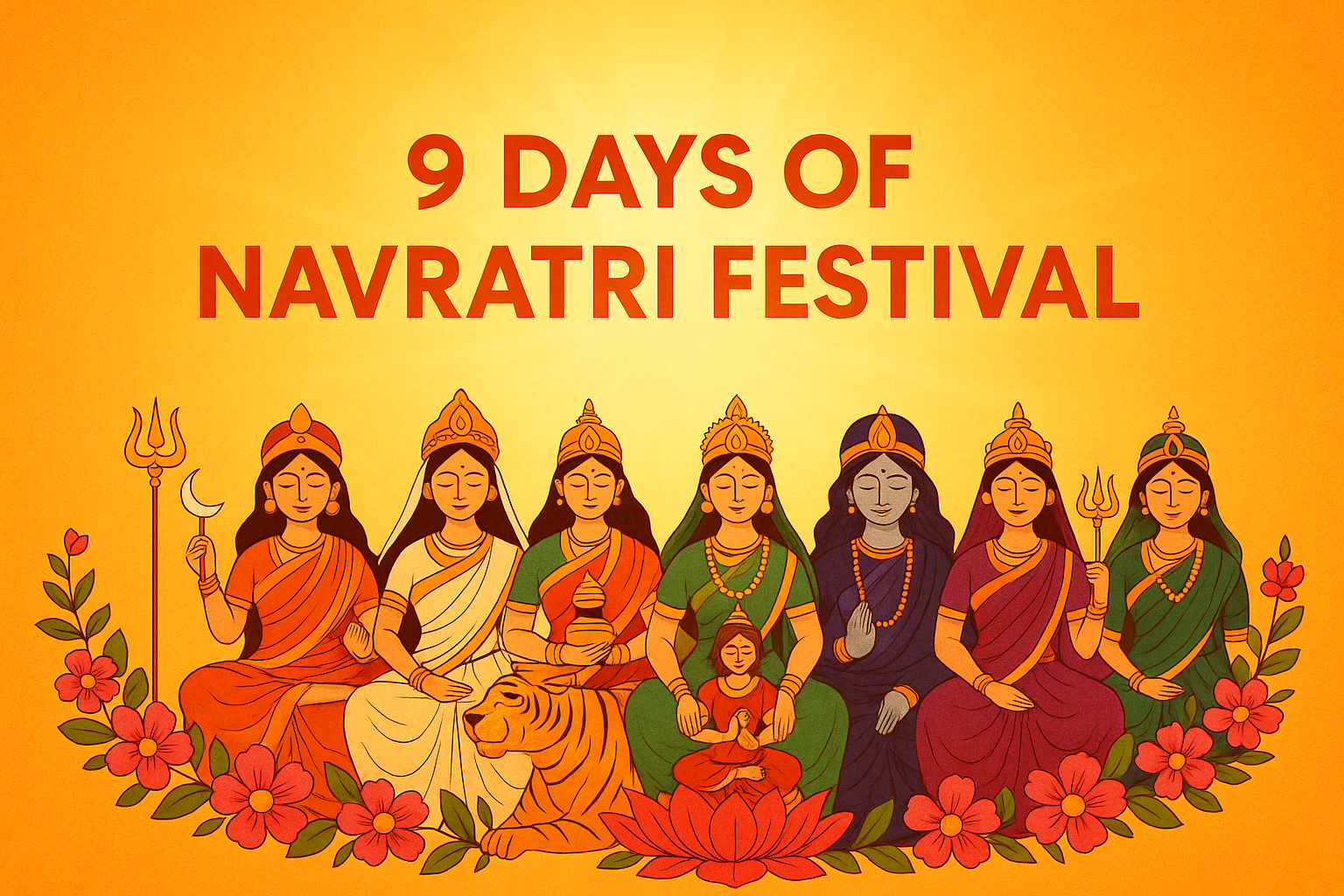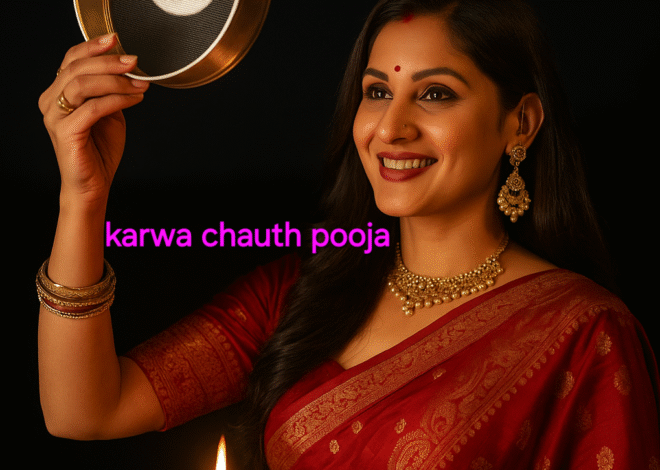
9 Days of Navratri Festival: Significance, Colors & Rituals
Navratri, one of the most celebrated Hindu festivals, is a vibrant and spiritual journey that lasts for nine days (नौ दिन). This festival is dedicated to the worship of Maa Durga (माँ दुर्गा) and her nine divine forms, known as the Navadurga (नवदुर्गा). Each day of Navratri is marked by devotion, fasting, colorful outfits, traditional dances like Garba and Dandiya, and prayers that connect people deeply with spirituality.
In this blog, let’s explore the significance of all nine days of Navratri, the colors associated with each day, and how people celebrate this auspicious festival across India.
🌼 What is Navratri?
The word Navratri comes from two Sanskrit words – Nav (nine) and Ratri (nights). It symbolizes the victory of good over evil. During these nine nights, devotees worship the nine forms of Goddess Durga, who represents power, purity, and protection.
Sharad Navratri (शरद नवरात्रि) in September–October is the most popular and widely celebrated, leading up to Dussehra (Vijayadashami).
Other Navratris include Chaitra Navratri (March–April), Magha Navratri, and Ashadha Navratri, but the Sharad one holds special importance.
Here are the 9 Navratri 2025 colours :
- 22 Sept (Day 1 – Shailputri Maa) → White
- 23 Sept (Day 2 – Brahmacharini Maa) → Red
- 24 Sept (Day 3 – Chandraghanta Maa) → Royal Blue
- 25 Sept (Day 4 – Kushmanda Maa) → Yellow
- 26 Sept (Day 5 – Skandamata Maa) → Green
- 27 Sept (Day 6 – Katyayani Maa) → Grey
- 28 Sept (Day 7 – Kaalratri Maa) → Orange
- 29 Sept (Day 8 – Mahagauri Maa) → Peacock Green
- 30 Sept (Day 9 – Siddhidatri Maa) → Pink
👉 ये 2025 के नवरात्रि के 9 दिन के रंग हैं।
🌺 Day-Wise Significance of 9 Days of Navratri
Each day of Navratri is dedicated to one form of Maa Durga. Let’s go through them one by one:
Day 1 – Maa Shailputri (शैलपुत्री)
She is the daughter of the Himalayas, symbolizing strength and devotion
Devotees seek blessings for stability in life.
Day 2 – Maa Brahmacharini (ब्रह्मचारिणी)
Goddess of meditation and wisdom.
Worshipping her brings knowledge and strength in hardships.
Day 3 – Maa Chandraghanta (चंद्रघंटा)
Known for her bravery and grace, she rides a tiger and wears a half-moon on her forehead.
She protects her devotees from evil forces.
Day 4 – Maa Kushmanda (कूष्माण्डा)
Creator of the universe with her divine smile, also called Adishakti.
Worshipping her brings health and wealth.
Day 5 – Maa Skandamata (स्कंदमाता)
She is the mother of Lord Kartikeya (Skanda). She blesses her devotees with power and wisdom.
Day 6 – Maa Katyayani (कात्यायनी)
Fierce warrior form of Maa Durga, who killed demon Mahishasura.
Devotees pray for courage and protection.
Day 7 – Maa Kaalratri (कालरात्रि)
Known as the fiercest form, she destroys darkness and negativity.
Day 8 – Maa Mahagauri (महागौरी)
Symbol of peace and purity, she blesses devotees with wisdom and calmness.
Day 9 – Maa Siddhidatri (सिद्धिदात्री)
She grants wisdom, spiritual knowledge, and all kinds of siddhis (supernatural powers).
🪔 Rituals & Traditions of Navratri
- Ghatasthapana (कलश स्थापना): The festival begins with setting up a pot (Kalash) symbolizing Goddess Durga’s presence.
- Fasting (व्रत): Many devotees observe fasts, eating only fruits, milk, or specific vrat foods like sabudana khichdi, kuttu ki puri, etc.
- Garba & Dandiya Nights: Especially popular in Gujarat and Maharashtra, people dress in colorful traditional attire and celebrate with dance.
- Durga Puja (दुर्गा पूजा): In West Bengal, Navratri overlaps with grand Durga Puja celebrations.
- Kanya Pujan (कन्या पूजन): On the 8th or 9th day, little girls (symbolizing Devi) are worshipped and offered food, gifts, and blessings.
🌸 Importance of Colors in Navratri
Wearing the specific color of each day is considered highly auspicious. It not only spreads positivity but also makes the festival more vibrant. Many people follow the “9-color Navratri fashion” trend, especially women, to celebrate each day with devotion and style.
🎉 Regional Celebrations of Navratri
Gujarat: Known for Garba & Dandiya Raas.
Maharashtra: Devotees visit temples and wear color-coded dresses.
West Bengal: Huge Durga Puja pandals with idols, music, and rituals.
North India: Ramlila plays and Dussehra mark the victory of Lord Rama over Ravana.
South India: People display “Golu dolls” and perform traditional pujas.
💡 Tips for Celebrating Navratri Mindfully
👉 Wear the Navratri colors with devotion.
👉 Try simple vrat-friendly recipes at home.
👉 Participate in Garba/Dandiya to experience cultural joy.
👉 Teach children about the stories of Maa Durga.
👉 Spread positivity by donating food/clothes to the needy.
❓ FAQs on Navratri
Q1. Why is Navratri celebrated for 9 days?
Each day represents one form of Maa Durga, who fought against demons and restored Dharma.
Q2. Can we wear black during Navratri?
Traditionally, black is avoided as it’s considered inauspicious, but in modern times, some wear it fashionably.
Q3. What is the most important day of Navratri?
All days are significant, but Ashtami (8th) and Navami (9th) are considered highly auspicious.
✨ Conclusion
The 9 Days of Navratri Festival are not just about rituals but about embracing positivity, devotion, and cultural vibrance. Every day inspires us with different values – strength, courage, purity, wisdom, and love. Whether you fast, play Garba, or simply wear the color of the day, Navratri is a reminder that good always triumphs over evil.
🌺 This Navratri, may Maa Durga bless you with happiness, health, and prosperity! 🌺



